SHARE
What is Spring Boot in Java? An Overview in 2026

Contents
Contents
Introduction
In the world of web development, backend frameworks play a necessary role in building robust and scalable applications.
One such popular framework is Spring Boot, which leverages the power of Java to simplify the development process.
Below, we will explore what a backend framework is, discuss Java basics, and provide an overview of the features of Spring Boot.
We will also discuss its popularity, advantages, and disadvantages. This will enable you to understand its significance in modern application development and see why you should use Spring Boot for your next Java-based project.
What is a Backend Web Framework?
A backend framework is a collection of libraries, tools, and components that aid in the development of server-side applications.
It provides a foundation for building web services, handling database interactions, and managing the flow of data between the front and backend layers.
A framework streamlines development, improves code organization, and offers numerous features that enable developers to enhance their productivity.

What is Java?
Java is a versatile and widely adopted programming language renowned for its platform independence, strong community support, and extensive libraries.
It offers a robust foundation for building enterprise applications. With its object-oriented programming, Java provides encapsulation, inheritance, and polymorphism, making it a preferred choice for large-scale projects.
Spring Boot is built on top of Java, harnessing its capabilities to create efficient and scalable web applications.

What is the Java Spring Framework?
Spring is a lightweight framework for Java development. The underlying Spring framework provides for a comprehensively defined configuration and setup, leading to enterprise-level application development.
Spring tries to simplify the Java development process. One key feature of Spring is dependency injection.
Several modules like Spring MVC and Spring Security that are included out-of-the-box help to drastically reduce development time with their prewritten code.

What is Spring Boot?
Spring Boot is a Spring module. It is an opinionated framework, an extension built on the popular Spring framework, which simplifies further the development of Java and Spring applications.
It provides a set of conventions, defaults, and auto-configuration capabilities that eliminate the need for boilerplate code, allowing developers to focus on writing business logic.
Spring Boot embodies the principle of convention over configuration, enabling rapid application development and reducing the complexity associated with traditional Spring-based applications.
What is the difference between Spring and Spring Boot? Spring Boot Java applications feature:
- Embedded HTTP servers
- Deploy WAR files for Tomcat, Jetty, and Undertow
- The default setup for unit and integration tests
Therefore, using Spring Boot is like using a Spring project initializer that auto-configures the project. This neatly handles one of the drawbacks of writing a Spring application – its lengthy config process.
Spring Boot application development is customizable according to the preferences of the coder. For example, there are several popular integrated development environments (IDEs) available for Java Spring Boot.
One open-source IDE is the Spring STS IDE which includes useful plugins with a wide range of features.
Thus, while Java provides all the mechanical means to write a web app, Spring Boot adds ease of use and speedy implementation to the mix.
What is Spring Boot Used For?
Spring Boot is used for building Java-based applications, particularly backend or server-side applications.
It provides a simplified and opinionated approach to developing Java applications by leveraging the power of the Spring framework.
Here are some common use cases for Spring Boot:
Microservices
Spring Boot is widely used for developing microservices architectures. It allows developers to build and deploy individual services independently, enabling scalability and flexibility in distributed systems.
RESTful APIs
Spring Boot makes it easy to develop RESTful APIs by providing built-in support for creating and managing REST endpoints. It simplifies request handling, parameter binding, and response serialization, allowing developers to focus on implementing business logic.
Web Applications
Spring Boot can be used to build web applications, both monolithic and modular. It provides integration with popular web frameworks such as Spring MVC, allowing developers to create feature-rich and scalable web applications.
Powerful Batch Processing
Spring Boot offers features for developing batch-processing applications. It provides a robust foundation for executing scheduled tasks, processing large volumes of data, and managing complex workflows efficiently.
Integration Projects
Spring Boot excels in integrating different systems and technologies. It provides extensive support for messaging systems, database integration, and third-party services, enabling seamless communication and data exchange between systems.
Prototyping and Rapid Development Time
Spring Boot’s simplicity and convention-over-configuration approach make it ideal for prototyping and rapid application development.
It reduces the time and effort required to set up and configure projects, allowing developers to focus on delivering functionality quickly.
Overall, Spring Boot is a versatile framework that can be used in various Java-based projects, ranging from small-scale applications to enterprise-level systems.
Its flexibility, extensive ecosystem, and integration capabilities make it a popular choice for developers looking to build robust and scalable applications efficiently.
How Popular is Spring Boot?
Spring Boot has gained immense popularity among developers for several reasons. Firstly, its simplicity and ease of use make it accessible to developers of varying experience levels.
Additionally, Spring Boot promotes best practices by incorporating industry standards and reducing the need for manual configuration.
It also offers a vast ecosystem with extensive community support, abundant learning resources, and a vibrant developer community.
Spring Boot’s popularity has made it the go-to framework for building microservices, RESTful APIs, and enterprise-grade applications.
Advantages of Spring Boot Applications
Several Spring Boot features push Java developers to take advantage of the development environment that the Spring framework offers.
Rapid Development Time
Spring Boot’s auto-configuration and convention over configuration approach enable developers to quickly bootstrap projects and focus on business logic rather than infrastructure setup.
For example, the Spring Initializr allows you to fill out a simple web form and lets Spring Boot decide which dependencies to include by default based on typical use cases.
With a Spring Boot starter like Spring Initializr, dependency management becomes a breeze and you get a jump start on app development.
Another helpful debugging feature is the built-in command line interface (CLI) tool that lets a Spring Boot application run and is tested from the command prompt.
Robustness and Scalability
Leveraging the power of Java and the Spring ecosystem, Spring Boot provides a robust and scalable foundation for building high-performance applications.
Production-Ready Features
Spring Boot incorporates features such as health monitoring, metrics, and security out of the box, making applications production-ready with minimal effort.
Seamless Integration
It seamlessly integrates with other Spring projects, allowing developers to leverage the full potential of the Spring ecosystem.
Disadvantages of Spring Boot Applications
On the other hand, we would be remiss if we didn’t address why Spring Boot is sometimes passed over by Java enthusiasts.
Learning Curve
Despite its simplicity, Spring Boot has a learning curve, especially for beginners who are new to the Spring ecosystem.
Learning Spring Boot does require an understanding of both Java and Spring. While there are Spring Boot tutorials readily available online, a deeper understanding of the base programming language will shorten the uphill climb.
Overhead
Spring Boot’s auto-configuration can sometimes lead to an overhead in terms of memory consumption and startup time, especially for smaller applications where such capabilities may not be required.
Summary
Spring Boot has emerged as a leading backend framework in the Java ecosystem, providing developers with a powerful and streamlined approach to application development.
Its simplicity, extensive ecosystem, and ability to rapidly build production-ready applications make it a preferred choice for many developers and organizations.
While it has a learning curve and some associated overhead, the advantages and popularity of Spring Boot far outweigh any drawbacks.
With Spring Boot, developers can focus on building robust, scalable, and high-performing applications, ultimately accelerating the software development process.
Frequently Asked Questions
What is a web framework?
A web framework is software designed to support the development, building, and management of web applications. It provides resources and tools that extend the functionality of the underlying base programming language and often simplify the coding process.
What is a Java framework?
Java frameworks are web frameworks specific to the Java programming language. Pre-built libraries and modules provide common functionality which allows the designer to create standalone applications using reusable code. The Spring framework and Spring Boot framework are two examples of Java frameworks.
Is Spring Boot good for web development?
Spring Boot is a good choice for custom web development if you already have an understanding of the Java language. One nice feature is that Spring Boot includes embedded servers that result in standalone applications that run on their own.
Is Spring Boot good for mobile development?
Spring Boot may be a good choice as the back end for an Android or iOS app. It is popular and widely used. It provides a lot of features out-of-the-box that can make app development and deployment easier. It is also easy to integrate with other technologies through powerful data access features like connections to databases and message queues.
Are there a lot of Spring Boot developers?
Spring Boot is supported by a large community of developers and is reported as the most popular Java framework through recent surveys.
Comprehensive Web Development Services
Flatirons Development creates custom web development solutions tailored to your business needs.
Get the CEO's Take
Handpicked tech insights and trends from our CEO.
Comprehensive Web Development Services
Flatirons Development creates custom web development solutions tailored to your business needs.
Get the CEO's Take
Handpicked tech insights and trends from our CEO.

What is IT OT Convergence? Streamlining Operations for Efficiency
Flatirons Development
Oct 28, 2025
Secure Mobile App Development: Prioritizing Data Protection
Flatirons Development
Oct 22, 2025
What is Data Ingestion? Definition, Types, and Best Practices for Efficient Data Processing
Flatirons Development
Oct 16, 2025
Enterprise Computing: Transforming Business Operations
Flatirons Development
Oct 09, 2025
Explore the Top Embedded Systems Examples of Today
Flatirons Development
Oct 04, 2025
What is IT OT Convergence? Streamlining Operations for Efficiency
Flatirons Development
Oct 28, 2025
Secure Mobile App Development: Prioritizing Data Protection
Flatirons Development
Oct 22, 2025
What is Data Ingestion? Definition, Types, and Best Practices for Efficient Data Processing
Flatirons Development
Oct 16, 2025
What is IT OT Convergence? Streamlining Operations for Efficiency
Flatirons Development
Oct 28, 2025
Secure Mobile App Development: Prioritizing Data Protection
Flatirons Development
Oct 22, 2025
What is Data Ingestion? Definition, Types, and Best Practices for Efficient Data Processing
Flatirons Development
Oct 16, 2025
What is IT OT Convergence? Streamlining Operations for Efficiency
Flatirons Development
Oct 28, 2025
Secure Mobile App Development: Prioritizing Data Protection
Flatirons Development
Oct 22, 2025
What is Data Ingestion? Definition, Types, and Best Practices for Efficient Data Processing
Flatirons Development
Oct 16, 2025